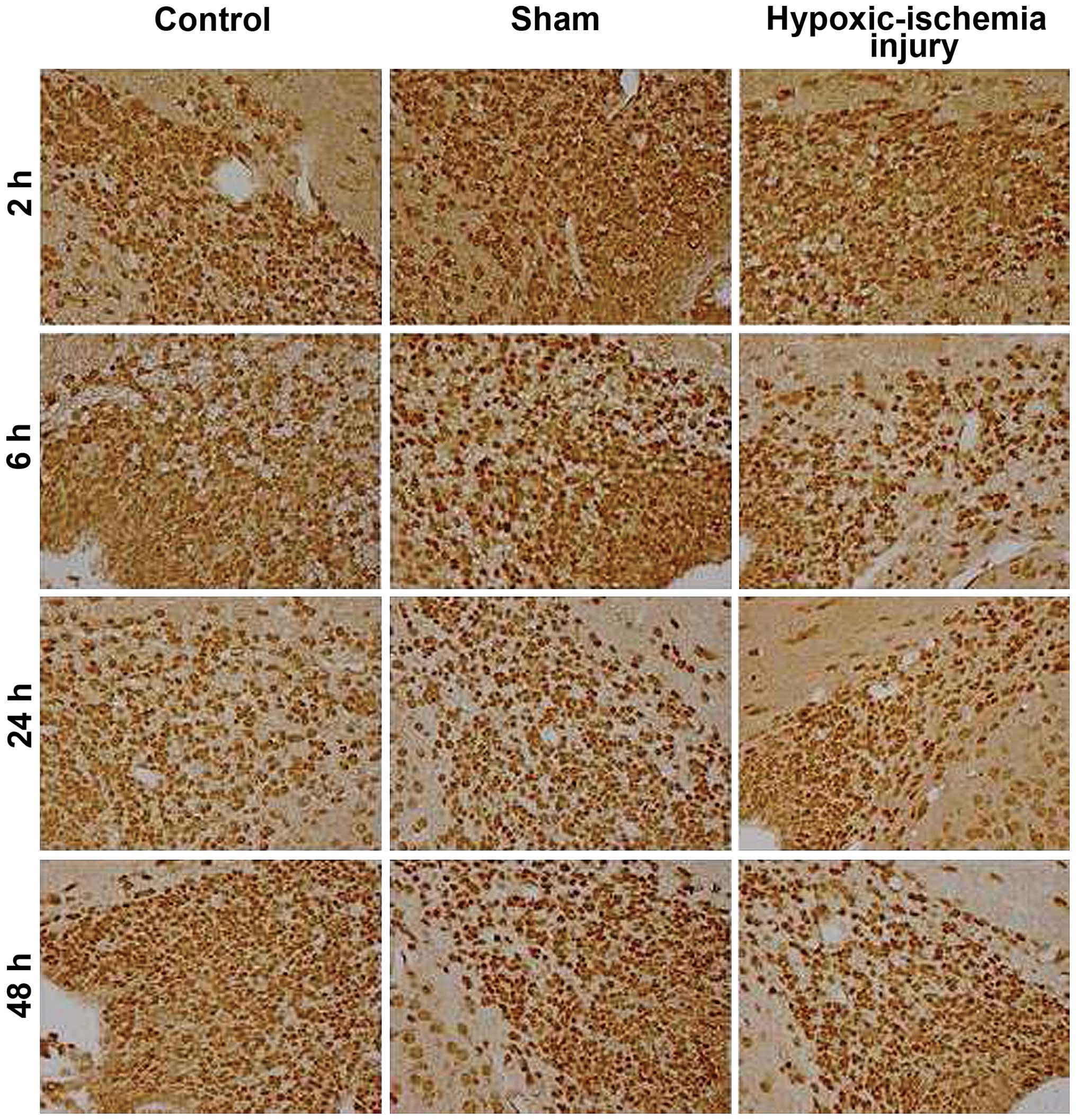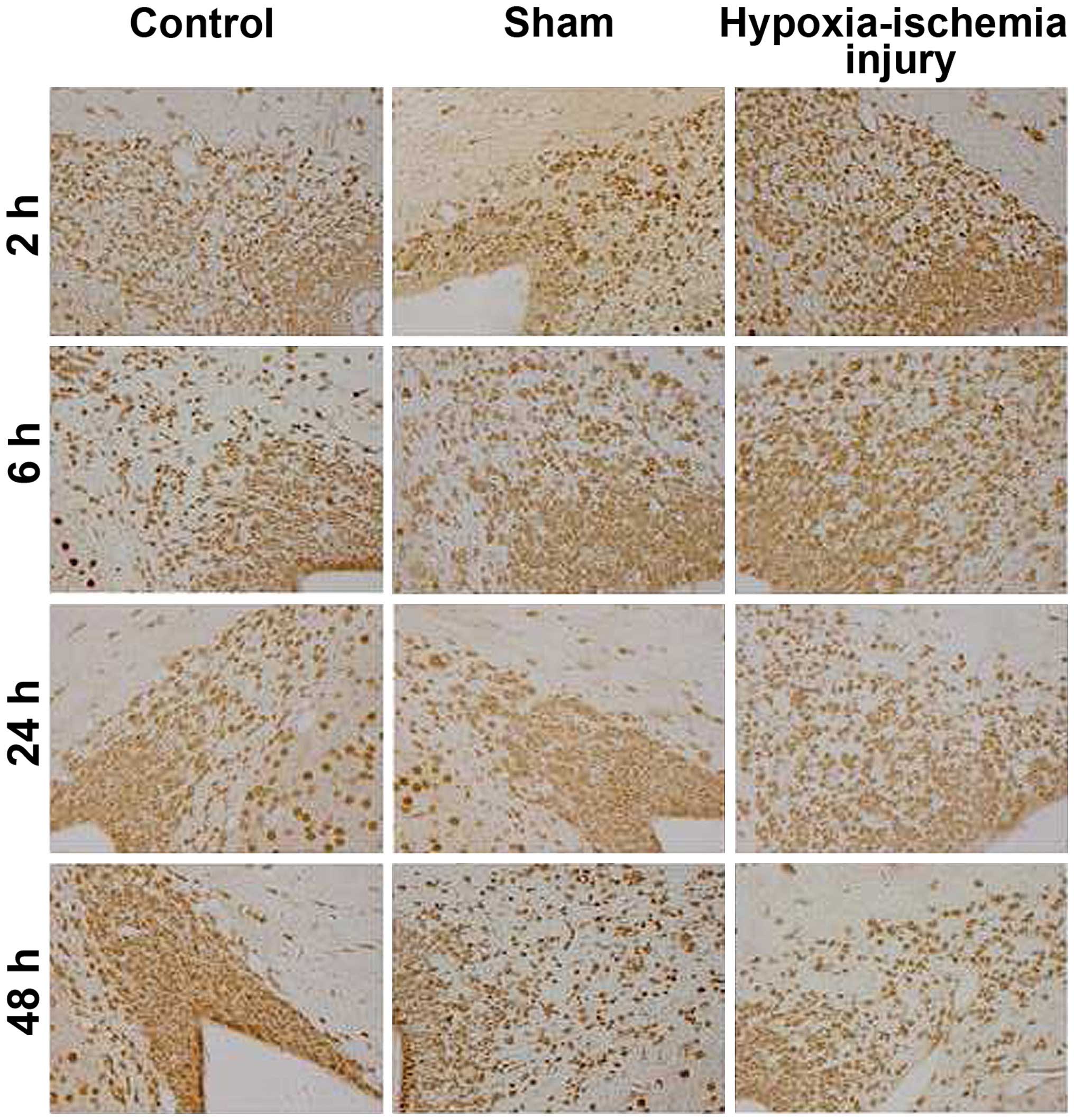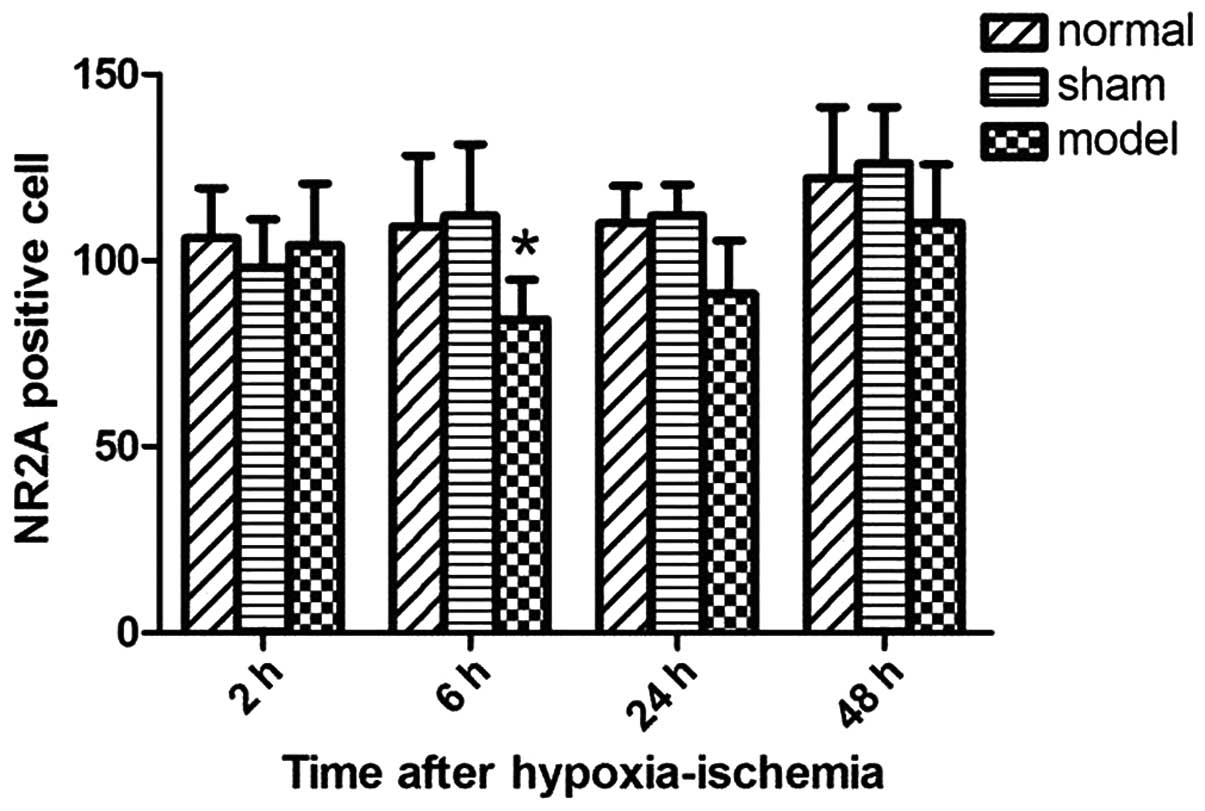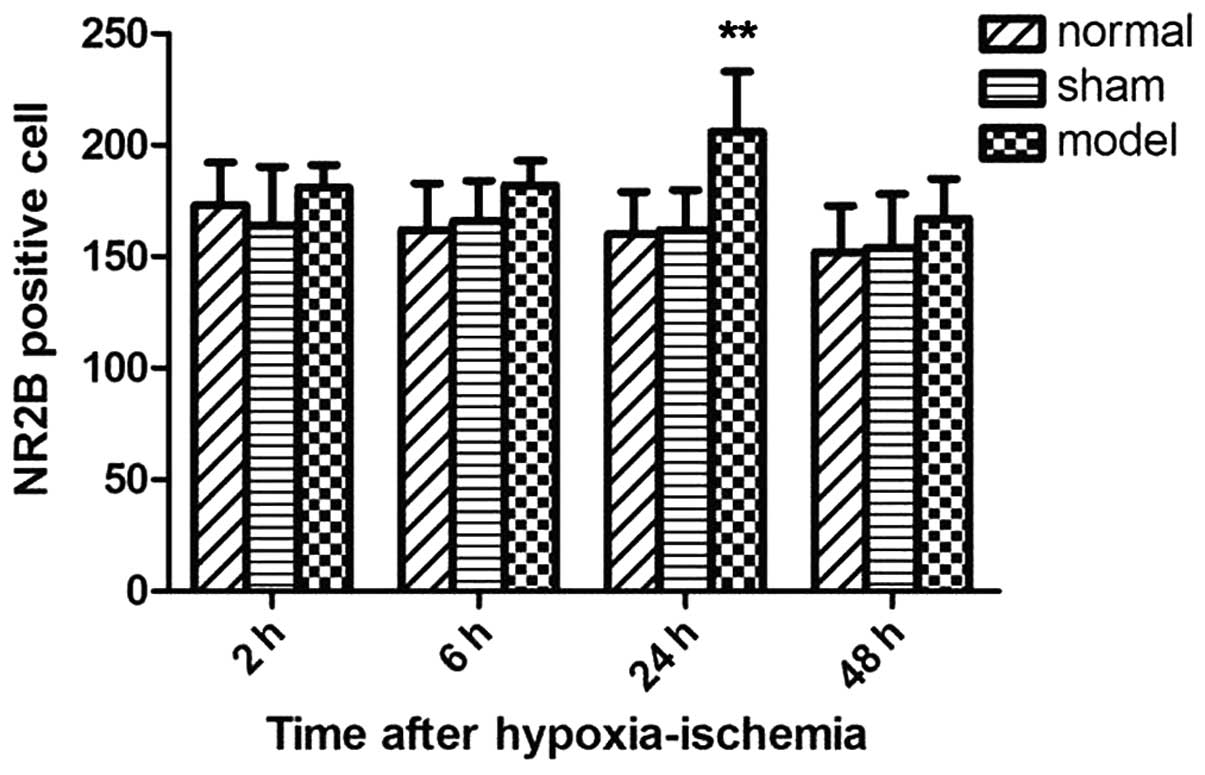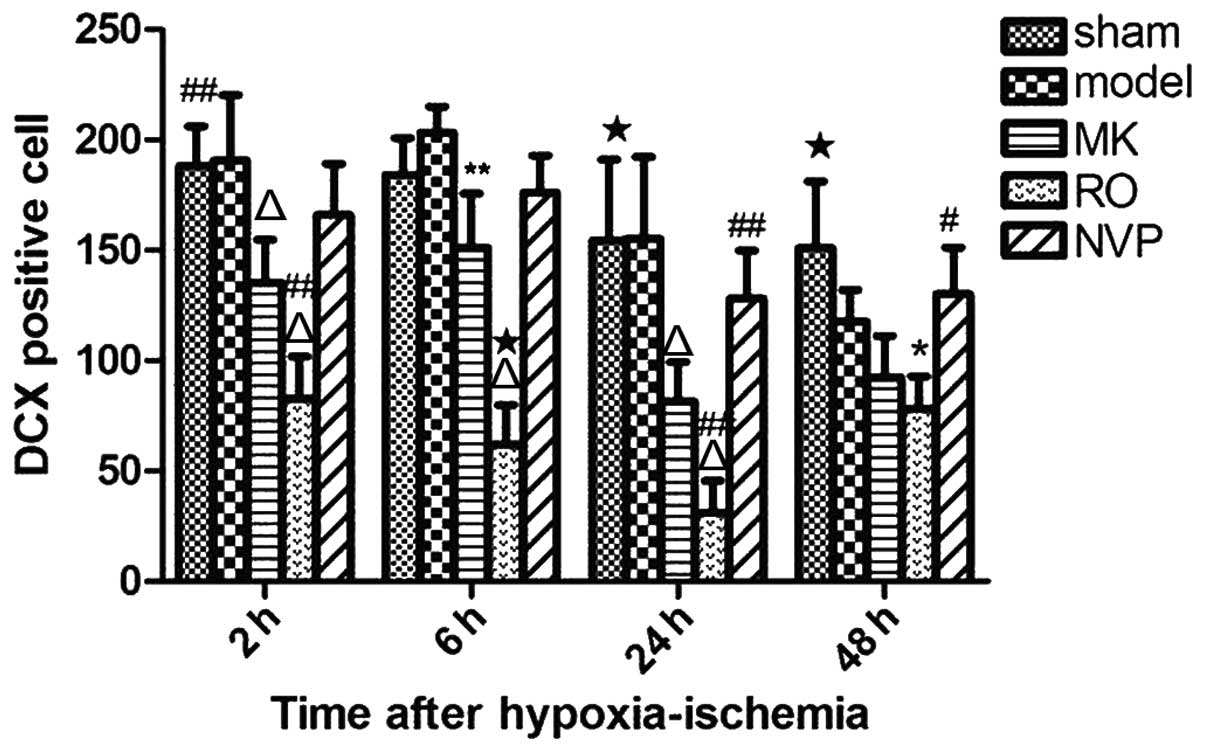NMDA receptors promote neurogenesis in the neonatal rat subventricular zone following hypoxic‑ischemic injury
- Authors:
- Published online on: November 4, 2015 https://doi.org/10.3892/mmr.2015.4501
- Pages: 206-212
-
Copyright: © Lai et al. This is an open access article distributed under the terms of Creative Commons Attribution License.
Abstract
Introduction
Neurogenesis is coordinated by cell proliferation, migration, differentiation, synaptogenesis and apoptosis (1). The subventricular zone (SVZ) of the lateral ventricle is one of the restricted neurogenesis regions in the central nervous system (2–5). Under normal conditions, neurogenesis is modulated by N-methyl-D-aspartate receptor (NMDAR) (6). NMDAR is a subtype of ionotropic glutamate receptors. NMDAR is a heterodimer primarily comprising NR1 and NR2 (A–D) subunits (7), while the NR3 subunit is identified less frequently (8). Functional properties of NMDAR are strongly influenced by the type of NR2 subunits (7). NMDAR comprises NR2A and NR2B, which are involved in synaptic plasticity and in pathological conditions (9–11). We recently demonstrated that NR2A and NR2B are expressed starting postnatal day 1 to postnatal day 28 in the SVZ, with each subunit showing a distinct expression pattern (12). Furthermore, NR2A and NR2B are differentially expressed in hypoxic-ischemic (13) and ischemia-reperfusion (14) injuries of the hippocampus. In addition, NMDAR plays an important role in glutamate neurotoxicity following hypoxic-ischemic injury (15). However, whether hypoxic-ischemic injury exerts an effect on the expression of NMDAR subunits in the SVZ remains to be determined.
In the normal adult hippocampus, the NR2B-containing NMDAR subtypes negatively regulate neurogenesis (16), while those with NR2A promote neurogenesis (17). This indicates that NMDAR subunits differentially regulate neurogenesis. The effects of NMDAR subunits on neurogenesis under pathological conditions, such as hypoxic-inschemic injury, remain to be elucidated. To address this knowledge gap, in the present study, we assessed the effects of NMDAR subunits on neurogenesis in the SVZ during hypoxic-ischemic injury.
Materials and methods
Animals
A total of 160, 7-day-old newborn Sprague-Dawley rats weighing between 12 and 18 g, of both genders, were provided by the Laboratory Animal Center of Xuzhou Medical College (Jiangsu, China). Animal use was regulated by the Animal Research Principles and Procedures established by the University's Animal Care Committee, as well as in accordance with the National Institute of Health Guide for the Care and Use of Laboratory Animals. In the first experiment, 60 animals were randomly divided into three groups of 20 animals (control, sham and hypoxic-ischemic injury groups). The animals in each group were fed normally until a specific time point (2, 6, 24 or 48 h after hypoxic-ischemic injury), and then sacrificed. In the second experiment, 100 rats were randomly divided into five groups: sham group, hypoxic-ischemic injury group, hypoxic-ischemic injury+MK-801 (selective non-competitive NMDAR antagonist) group, hypoxic-ischemic injury+NVP-AAM077 (NR2A antagonist) group, and hypoxic-ischemic injury+Ro25-6981 (NR2B antagonist) group. The animals in each group were sacrificed at a specific time point (2, 6, 24 or 48 h after hypoxic-ischemic injury).
Equipment and reagents
Selective non-competitive NMDAR antagonist MK-801 (M107), NR2A antagonist NVP-AAM077 (P1999), and NR2B antagonist Ro25-6981 (R7150) were purchased from Sigma-Aldrich (St. Louis, MO, USA). The 3,3′-diaminobenzidine (DAB) solution was obtained from Beijing Jinqiao Biotechnology Co., Ltd., (Beijing, China). The Polink-2 plus polymer horseradish peroxidase detection systems for rabbit and mouse primary antibodies were also purchased from Beijing Jinqiao Biotechnology Co., Ltd.. Mouse monoclonal anti-Nestin antibody (ab11306), rabbit polycloncal anti-DCX antibody (ab18723), rabbit polycloncal anti-NR2A antibody (ab84181), and rabbit polyclonal anti-NR2B antibody (ab65875) were purchased from Abcam (Hong Kong, China). The paraffin wax slicing machine RM2235 was purchased from Leica (Wetzlar, Germany), the photomicrography system DP25 was purchased from Olympus Corp. (Osaka, Japan), and the image analysis software Image-Pro Plus 6.0 was purchased from Media Cybernetics, Inc. (Chicago, IL, USA).
Hypoxic-ischemic injury
The hypoxic-ischemic injury was modeled with minor modifications as previously described (18). The animals in the control group were anesthetized with ether and not subjected to hypoxia-ischemia. Animals in the sham and hypoxic-ischemic injury groups received intraperitoneal injections of sterile saline, while animals in the drug intervention groups (MK, NVP and Ro groups) received intraperitoneal injections of selective non-competitive NMDAR antagonist MK-801 (0.5 mg/kg), NR2A antagonist NVP-AAM077 (5 mg/kg), and NR2B antagonist Ro25-6981 (5 mg/kg) 30 min prior to the induction of hypoxia-ischemia. The animals of the sham, hypoxic-ischemic, and drug intervention groups were anesthetized with ether and subjected to hypoxia-ischemia. Specifically, after drug injection for 30 min, the right common carotid artery was clamped. The animals were then placed in a container and perfused for 2 h at 37°C with a gas mixture consisting of 8% oxygen and 92% nitrogen, at 1.5–2.5 l/min. After the treatment, the rats were fed again.
Immunohistochemical staining
The rats were deeply anesthetized with chloral hydrate and perfused intracardially with physiological saline solution, followed by 4% paraformaldehyde. At the end of perfusion, the brains were removed and fixed overnight in 4% paraformaldehyde at 4°C. The tissues were rinsed with water, dehydrated through an ascending series of alcohol, and embedded in paraffin through xylene. Sections (4-μm) were cut using a Leica paraffin wax slicing machine. Antigen retrieval was performed in a citrate antigen retrieval solution using a microwave oven (Galanz Corp., Guangzhou, China). The sections were cooled to room temperature and transferred to 3% hydrogen peroxide for 10 min to block endogenous peroxidase. The sections were washed three times with 0.01 M phosphate buffered saline (PBS; 5 min each wash) and blocked with appropriate serum for 1 h at 37°C. The slices were incubated with primary antibodies overnight at 4°C. The primary antibodies were diluted 1:100 (anti-NR2A), 1:200 (anti-NR2B), 1:500 (anti-Nestin), and 1:200 (anti-DCX). Subsequently, the sections were equilibrated to room temperature, washed with PBS (pH 7.4) for 5 min, and incubated with appropriate secondary antibodies for 30 min at 37°C. This step was followed by 3×5 min washes in PBS. The sections were then treated with DAB solution according to the manufacturer's instructions. The slices were then washed with distilled water to remove the reagent. The slices were microscopically examined, and the images captured using the Olympus DP25 photomicrography system (Olympus. Corp. Japan). To control for the specificity of the staining, parallel slices were stained identically but without primary antibodies.
Positive cell count
Cells were counted in at least five 100×100 μm2 areas of each section of three serially sectioned brains. The number of NR2A-, NR2B-, or DCX-positive cells in the SVZ was counted at each time point. The Nestin immunoexpression images were subsequently processed by densitometry with the Image-Pro Plus image analysis software, and integrated optical density (IOD) of at least five 100×100 μm2 areas of each section of three serially sectioned brains were obtained.
Statistical analysis
Data are presented as mean ± standard deviation. The two-tailed Student's t-test and one-way analysis of variance tests were used for statistical comparisons. The Student's Newman-Keuls and Dunnet tests were used for post hoc analysis. P<0.05 was considered to indicate a statistically significant difference.
Results
Effects of hypoxia-ischemia on the expression of NR2A and NR2B subunits in the SVZ
NMDAR subunits NR2A and NR2B were expressed in the SVZ cells of rat brain at 2, 6, 24 and 48 h following hypoxic-ischemic injury. NR2A-positive cells were mainly located in the dorsal lateral horn of the lateral ventricle (Fig. 1). The majority of the positive cells were distributed irregularly in the SVZ, with the exception of the ependymal layer. NR2A-positive cells in the membrane and cytoplasm showed strong immunopositivity. NR2B immuno-expression was also detected in a similar location (Fig. 2). The immunoreactivity of NR2B was weaker than that of NR2A at each tested time point.
Expression of NR2A showed a 'decreased first and then increased' pattern. At 6 h after hypoxic-ischemia injury, NR2A expression significantly decreased (P<0.05 vs. control group; Fig. 3). The difference between the hypoxic-ischemic injury and control groups did not reach statistical significance at 24 and 48 h after induction of hypoxic-ischemia injury. By contrast, the expression of NR2B showed the opposite trend and reached the maximum at 24 h after hypoxia-ischemia (P<0.01 vs. control group; Fig. 4).
Effects of NMDAR antagonists on the expression of Nestin in SVZ
The cytoplasm and neurites of Nestin-positive cells showed strong immunoreactivity. Nestin-positive cells were mainly located in the dorsal lateral horn of the lateral ventricle (Fig. 5).
At 48 h after hypoxic-ischemia injury, the Nestin-positive IOD value of the hypoxic-ischemic group was increased significantly compared with the sham group (P<0.05; Fig. 6). Hypoxic-ischemia injury exerted no significant effect on Nestin expression at 2, 6 and 24 h after hypoxia-ischemic injury compared with the sham group (Fig. 6). Compared with the hypoxic-ischemic injury group, the animals treated with MK-801 or Ro25-6981 showed a reduced expression of Nestin in the SVZ at 6 and 24 h after hypoxia-ischemia (Fig. 6), and the animals treated with Ro25-6981 compound demonstrated a more pronounced downregulation (P<0.05 vs. MK group; Fig. 6). At 48 h after hypoxia-ischemia, the IOD value in the Ro group was significantly decreased compared with the hypoxic-ischemic injury group (P<0.05; Fig. 6). This result was in contrast to the MK group (Fig. 6). In addition, compared with the MK group, the NVP group (animals pre-treated with NVP-AAM077) showed a marked increase at 6 and 24 h after hypoxia-ischemia (P<0.05; Fig. 6).
Effect of NMDAR antagonists on the expression of DCX in SVZ
DCX-positive cells were mainly located in the dorsal lateral horn of the lateral ventricle as well as in the basal ganglia. The outline shape of the positive cells was regular and intensive in arrangement. Membranes and cytoplasms of the DCX-positive cells showed strong immunopositivity in DAB staining (Fig. 7).
Compared with the hypoxic-ischemic group, the animals pre-treated with MK-801 or Ro25-6981 (MK and Ro groups, respectively) showed a markedly reduced number of DCX protein-positive cells in the SVZ at 2, 6 and 24 h after hypoxia-ischemia (Fig. 8). Additionally, fewer positive cells were identified in the Ro group compared with the MK group (Fig. 8). At 48 h after hypoxia-ischemia, the number of DCX protein-positive cells in the Ro group was significant lower compared with the sham group (Fig. 8). This was not the case for the MK group (Fig. 8). In addition, compared with animals in the MK group, animals pre-treated with NVP-AAM077 (NVP group) showed a markedly increased number of positive cells at 24 and 48 h after hypoxia-ischemia (Fig. 8). The difference between the sham and MK groups reached statistical significance at 2, 24 and 48 h after hypoxia-ischemia (Fig. 8).
Discussion
NMDARs play an important role in normal brain development and are involved in excitotoxicity in hypoxic-ischemic injury (19). In the present study, we report that hypoxic-ischemic injury leads to an increased expression of NR2B and a decreased expression of NR2A subunits in the SVZ of neonatal rats. Furthermore, in neonatal rats, hypoxic-ischemic injury stimulates neurogenesis in the SVZ, which is inhibited by NMDA receptor antagonists. Based on these observations, NMDAR may promote neurogenesis in the SVZ of neonatal rats.
In our study, the animals exposed to hypoxia-ischemia demonstrated a significant upregulation of NR2B subunits 24 h after induction of the injury. This finding is in concordance with those of previous studies which described developmentally related changes in NMDAR expression (13,14,20). As reported previously (21), NR2A levels were markedly reduced at 6 h after hypoxia-ischemia, a finding that is consistent with our results. There are several mechanisms accounting for the observed developmental changes of NMDAR subunits in hypoxic-ischemic injury. The first mechanism involves glutamate excitotoxicity inducing truncation of the NR2A subunit and cleavage of the scaffolding protein PSD-95 (22). This NR2A subunit truncation may lead to a rapid uncoupling of synaptic NMDAR from the survival pathways and a decrease in synaptic NMDAR functionality. The second mechanism involves calcium overload being responsible for transcriptional blockage of the NMDAR obligatory subunit NR1 (23), which is involved in the downregulation of NMDAR functionality. Furthermore, the currents mediated by NR1/NR2A heteromers develop 3- to 4-fold faster than the NR1/NR2B-mediated currents (24). Therefore, a preferential decrease in NR2A may lead to an increase in the duration of NMDAR-mediated excitatory post-synaptic currents that may cause elevated calcium levels and greater sensitivity to excitotoxic cell damage. While these mechanisms have not been directly addressed in the present study, alterations in the NMDAR subunit expression may play a significant role in modulating the response of brain development follownig hypoxic-ischemic injury.
As for the NMDAR subunit of neonatal brain in the SVZ, whether this is a 'functional' or a 'silent' receptor remains to be determined. Additionally, whether a potential function of this receptor is associated with neurogenesis has yet to be investigated. In the present study, we observed that Nestin expression was significantly increased at 48 h after hypoxic-ischemic injury. This observation indicates that hypoxic-ischemic injury stimulates neural stem cell proliferation in the SVZ, as previously reported (25). In a previous study, we demonstrated that MK-801, a selective non-competitive NMDAR antagonist inhibits cell proliferation in the SVZ of neonatal rats (12). However, it was not clear whether MK-801 exerted its effect on neurogenesis in the SVZ under hypoxic-ischemic injury. We extended our previous observations in the current study and demonstrated that MK-801 inhibits the protein expression of Nestin and DCX in the SVZ. This finding is supported by previous studies showing that NMDAR activation increases proliferation in neural stem/progenitor cells in vitro and in vivo (26–31). At the same time, several studies suggest that NMDAR blockade in adult or aged hippocampus increases precursor proliferation and subsequent neuron production (16,32,33).
It is also unclear whether NMDA receptor antagonism inhibits neurogenesis mainly through inhibition of the NR2A or NR2B subunits. Our results show that the NR2B antagonist Ro25-6981 decreases Nestin and DCX protein expression in the SVZ. Therefore, NR2B-containing NMDAR may promote neurogenesis in the SVZ of neonatal rats. This hypothesis is supported by previous studies which showed that the NR2B-containing NMDARs promote neural progenitor cell proliferation (34). Our study demonstrates that the NR2A antagonist NVP-AAM077 exerted no significant effect on the protein expression of Nestin and DCX. Thus, blocking through NR2A NMDAR has no significant effect on neurogenesis in the SVZ. However, previous findings have shown that NVP-AAM077 reduced spatial learning by downregulating neurogenesis in the adult hippocampus (17). However, there is inconsistency in the literature regarding the role of NMDAR subunits in regulating neurogenesis. A number of mechanisms potentially account for the different effect of NMDAR subunits on neurogenesis. First, NMDAR subunit composition undergoes a change during postnatal development, with a high NR2B and low NR2A expression at postnatal early stage, and an increased expression of NR2A during postnatal development (10,35). A similar observation was made in our previous study (12). In the present study, at the early stage after the hypoxic-ischemic injury, the pattern of high NR2B and low NR2A expression was evident in the SVZ. The protein expression of Nestin and DCX was completely eliminated by Ro25-6981, an antagonist of NR2B-containing receptors, but not affected by NVP-AAM077, an NR2A-containing receptor antagonist. Second, the NR2A- and NR2B-containing NMDAR subtypes have opposing roles in the modulation of the direction of synaptic plasticity (36,37) or mediation of the NMDA-elicited neuronal survival and apoptosis (38), and are differently involved in ischemic neuronal cell death and ischemic tolerance (39). However, the mechanisms regarding NMDAR promotion of neurogenesis are poorly understood, and remain to be investigated.
In conclusion, hypoxic-ischemic injury upregulates the expression of NR2B and downregulates the expression of NR2A in the SVZ of neonatal rats. NMDA receptor antagonists (specifically NR2B) significantly decreased the expression of Nestin and DCX in this region in the neonatal brain. Therefore, the result show that NR2B-containing NMDA receptors promote neurogenesis in the SVZ of neonatal brain.
Acknowledgments
This study was partly supported by the Department of Clinical Pharmacology, School of Pharmacy, Xuzhou Medical College (Xuzhou, China).
References
|
Monk CS, Webb SJ and Nelson CA: Prenatal neurobiological development: Molecular mechanisms and anatomical change. Dev Neuropsychol. 19:211–236. 2001. View Article : Google Scholar : PubMed/NCBI | |
|
Charvet CJ, Owerkowicz T and Striedter GF: Phylogeny of the telencephalic subventricular zone in sauropsids: Evidence for the sequential evolution of pallial and subpallial subventricular zones. Brain Behav Evol. 73:285–294. 2009. View Article : Google Scholar : PubMed/NCBI | |
|
Curtis MA, Connor B and Faull RL: Neurogenesis in the diseased adult human brain - new therapeutic strategies for neurodegenerative diseases. Cell Cycle. 2:428–430. 2003. View Article : Google Scholar : PubMed/NCBI | |
|
Grote HE and Hannan AJ: Regulators of adult neurogenesis in the healthy and diseased brain. Clin Exp Pharmacol Physiol. 34:533–545. 2007. View Article : Google Scholar : PubMed/NCBI | |
|
Khodosevich K, Seeburg PH and Monyer H: Major signaling path ways in migrating neuroblasts. Front Mol Neurosci. 2:72009. View Article : Google Scholar | |
|
Nacher J and McEwen BS: The role of N-methyl-D-asparate receptors in neurogenesis. Hippocampus. 16:267–270. 2006. View Article : Google Scholar : PubMed/NCBI | |
|
Cull-Candy S, Brickley S and Farrant M: NMDA receptor subunits: Diversity, development and disease. Curr Opin Neurobiol. 11:327–335. 2001. View Article : Google Scholar : PubMed/NCBI | |
|
Prybylowski K and Wenthold RJ: N-Methyl-D-aspartate receptors: Subunit assembly and trafficking to the synapse. J Biol Chem. 279:9673–9676. 2004. View Article : Google Scholar : PubMed/NCBI | |
|
Krapivinsky G, Krapivinsky L, Manasian Y, Ivanov A, Tyzio R, Pellegrino C, Ben-Ari Y, Clapham DE and Medina I: The NMDA receptor is coupled to the ERK pathway by a direct interaction between NR2B and RasGRF1. Neuron. 40:775–784. 2003. View Article : Google Scholar : PubMed/NCBI | |
|
Liu XB, Murray KD and Jones EG: Switching of NMDA receptor 2A and 2B subunits at thalamic and cortical synapses during early postnatal development. J Neurosci. 24:8885–8895. 2004. View Article : Google Scholar : PubMed/NCBI | |
|
Kim MJ, Dunah AW, Wang YT and Sheng M: Differential roles of NR2A- and NR2B-containing NMDA receptors in Ras-ERK signaling and AMPA receptor trafficking. Neuron. 46:745–760. 2005. View Article : Google Scholar : PubMed/NCBI | |
|
Fan H, Gao J, Wang W, Li X, Xu T and Yin X: Expression of NMDA receptor and its effect on cell proliferation in the subventricular zone of neonatal rat brain. Cell Biochem Biophys. 62:305–316. 2012. View Article : Google Scholar | |
|
Ma ZL, Gu XP, Zeng YM and Zhang Y: Effect of sodium hydroxybutyrate on the expression of hippocampal N-methyl-D-aspartate receptor 2B subunit mRNA in neonatal rats with hypoxic-ischemic insult. Ann Clin Lab Sci. 36:307–311. 2006.PubMed/NCBI | |
|
Sutcu R, Altuntas I, Eroglu E and Delibas N: Effects of ischemia-reperfusion on NMDA receptor subunits 2a and 2b level in rat hippocampus. Int J Neurosci. 115:305–314. 2005. View Article : Google Scholar : PubMed/NCBI | |
|
Savignon T, Costa E, Tenorio F, Manhães AC and Barradas PC: Prenatal hypoxic-ischemic insult changes the distribution and number of NADPH-diaphorase cells in the cerebellum. PLoS One. 7:e357862012. View Article : Google Scholar : PubMed/NCBI | |
|
Hu M, Sun YJ, Zhou QG, Chen L, Hu Y, Luo CX, Wu JY, Xu JS, Li LX and Zhu DY: Negative regulation of neurogenesis and spatial memory by NR2B-containing NMDA receptors. J Neurochem. 106:1900–1913. 2008. View Article : Google Scholar : PubMed/NCBI | |
|
Hu M, Sun YJ, Zhou QG, Auberson YP, Chen L, Hu Y, Luo CX, Wu JY, Zhu DY and Li LX: Reduced spatial learning in mice treated with NVP-AAM077 through downregulating neurogenesis. Eur J Pharmacol. 622:37–44. 2009. View Article : Google Scholar : PubMed/NCBI | |
|
Vannucci RC and Vannucci SJ: Perinatal hypoxic-ischemic brain damage: Evolution of an animal model. Dev Neurosci. 27:81–86. 2005. View Article : Google Scholar : PubMed/NCBI | |
|
Lynch DR and Guttmann RP: Excitotoxicity: Perspectives based on N-methyl-D-aspartate receptor subtypes. J Pharmacol Exp Ther. 300:717–723. 2002. View Article : Google Scholar : PubMed/NCBI | |
|
Guerguerian AM, Brambrink AM, Traystman RJ, Huganir RL and Martin LJ: Altered expression and phosphorylation of N-methyl-D-aspartate receptors in piglet striatum after hypoxia-ischemia. Brain Res Mol Brain Res. 104:66–80. 2002. View Article : Google Scholar : PubMed/NCBI | |
|
Gurd JW, Bissoon N, Beesley PW, Nakazawa T, Yamamoto T and Vannucci SJ: Differential effects of hypoxia-ischemia on subunit expression and tyrosine phosphorylation of the NMDA receptor in 7- and 21-day-old rats. J Neurochem. 82:848–856. 2002. View Article : Google Scholar : PubMed/NCBI | |
|
Gascón S, Sobrado M, Roda JM, Rodríguez-Peña A and Díaz-Guerra M: Excitotoxicity and focal cerebral ischemia induce truncation of the NR2A and NR2B subunits of the NMDA receptor and cleavage of the scaffolding protein PSD-95. Mol Psychiatry. 13:99–114. 2008. View Article : Google Scholar | |
|
Gascón S, Deogracias R, Sobrado M, Roda JM, Renart J, Rodríguez-Peña A and Díaz-Guerra M: Transcription of the NR1 subunit of the N-methyl-D-aspartate receptor is downregulated by excitotoxic stimulation and cerebral ischemia. J Biol Chem. 280:35018–35027. 2005. View Article : Google Scholar | |
|
Monyer H, Burnashev N, Laurie DJ, Sakmann B and Seeburg PH: Developmental and regional expression in the rat brain and functional properties of four NMDA receptors. Neuron. 12:529–540. 1994. View Article : Google Scholar : PubMed/NCBI | |
|
Yang Z and Levison SW: Hypoxia/ischemia expands the regenerative capacity of progenitors in the perinatal subventricular zone. Neuroscience. 139:555–564. 2006. View Article : Google Scholar : PubMed/NCBI | |
|
Arvidsson A, Kokaia Z and Lindvall O: N-methyl-D-aspartate receptor-mediated increase of neurogenesis in adult rat dentate gyrus following stroke. Eur J Neurosci. 14:10–18. 2001. View Article : Google Scholar : PubMed/NCBI | |
|
Luk KC, Kennedy TE and Sadikot AF: Glutamate promotes proliferation of striatal neuronal progenitors by an NMDA receptor-mediated mechanism. J Neurosci. 23:2239–2250. 2003.PubMed/NCBI | |
|
Deisseroth K, Singla S, Toda H, Monje M, Palmer TD and Malenka RC: Excitation-neurogenesis coupling in adult neural stem/progenitor cells. Neuron. 42:535–552. 2004. View Article : Google Scholar : PubMed/NCBI | |
|
Joo JY, Kim BW, Lee JS, Park JY, Kim S, Yun YJ, Lee SH, Lee SH, Rhim H and Son H: Activation of NMDA receptors increases proliferation and differentiation of hippocampal neural progenitor cells. J Cell Sci. 120:1358–1370. 2007. View Article : Google Scholar : PubMed/NCBI | |
|
Mochizuki N, Takagi N, Kurokawa K, Kawai T, Besshoh S, Tanonaka K and Takeo S: Effect of NMDA receptor antagonist on proliferation of neurospheres from embryonic brain. Neurosci Lett. 417:143–148. 2007. View Article : Google Scholar : PubMed/NCBI | |
|
Toriumi K, Mouri A, Narusawa S, Aoyama Y, Ikawa N, Lu L, Nagai T, Mamiya T, Kim HC and Nabeshima T: Prenatal NMDA receptor antagonism impaired proliferation of neuronal progenitor, leading to fewer glutamatergic neurons in the prefrontal cortex. Neuropsychopharmacology. 37:1387–1396. 2012. View Article : Google Scholar : PubMed/NCBI | |
|
Nacher J, Alonso-Llosa G, Rosell DR and McEwen BS: NMDA receptor antagonist treatment increases the production of new neurons in the aged rat hippocampus. Neurobiol Aging. 24:273–284. 2003. View Article : Google Scholar | |
|
Maekawa M, Namba T, Suzuki E, Yuasa S, Kohsaka S and Uchino S: NMDA receptor antagonist memantine promotes cell proliferation and production of mature granule neurons in the adult hippocampus. Neurosci Res. 63:259–266. 2009. View Article : Google Scholar : PubMed/NCBI | |
|
Li M, Zhang DQ, Wang XZ and Xu TJ: NR2B-containing NMDA receptors promote neural progenitor cell proliferation through CaMKIV/CREB pathway. Biochem Biophys Res Commun. 411:667–672. 2011. View Article : Google Scholar : PubMed/NCBI | |
|
Sans N, Petralia RS, Wang YX, Blahos J II, Hell JW and Wenthold RJ: A developmental change in NMDA receptor-associated proteins at hippocampal synapses. J Neurosci. 20:1260–1271. 2000.PubMed/NCBI | |
|
Liu L, Wong TP, Pozza MF, Lingenhoehl K, Wang Y, Sheng M, Auberson YP and Wang YT: Role of NMDA receptor subtypes in governing the direction of hippocampal synaptic plasticity. Science. 304:1021–1024. 2004. View Article : Google Scholar : PubMed/NCBI | |
|
Massey PV, Johnson BE, Moult PR, Auberson YP, Brown MW, Molnar E, Collingridge GL and Bashir ZI: Differential roles of NR2A and NR2B-containing NMDA receptors in cortical long-term potentiation and long-term depression. J Neurosci. 24:7821–7828. 2004. View Article : Google Scholar : PubMed/NCBI | |
|
Liu Y, Wong TP, Aarts M, Rooyakkers A, Liu L, Lai TW, Wu DC, Lu J, Tymianski M, Craig AM, et al: NMDA receptor subunits have differential roles in mediating excitotoxic neuronal death both in vitro and in vivo. J Neurosci. 27:2846–2857. 2007. View Article : Google Scholar : PubMed/NCBI | |
|
Chen M, Lu TJ, Chen XJ, Zhou Y, Chen Q, Feng XY, Xu L, Duan WH and Xiong ZQ: Differential roles of NMDA receptor subtypes in ischemic neuronal cell death and ischemic tolerance. Stroke. 39:3042–3048. 2008. View Article : Google Scholar : PubMed/NCBI |



